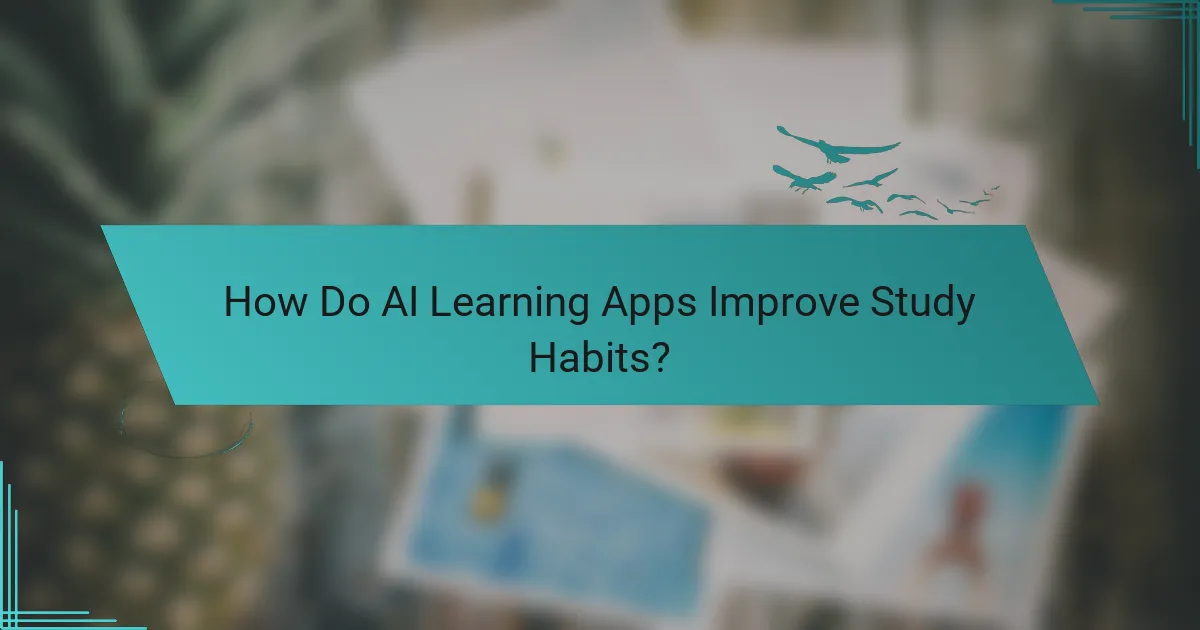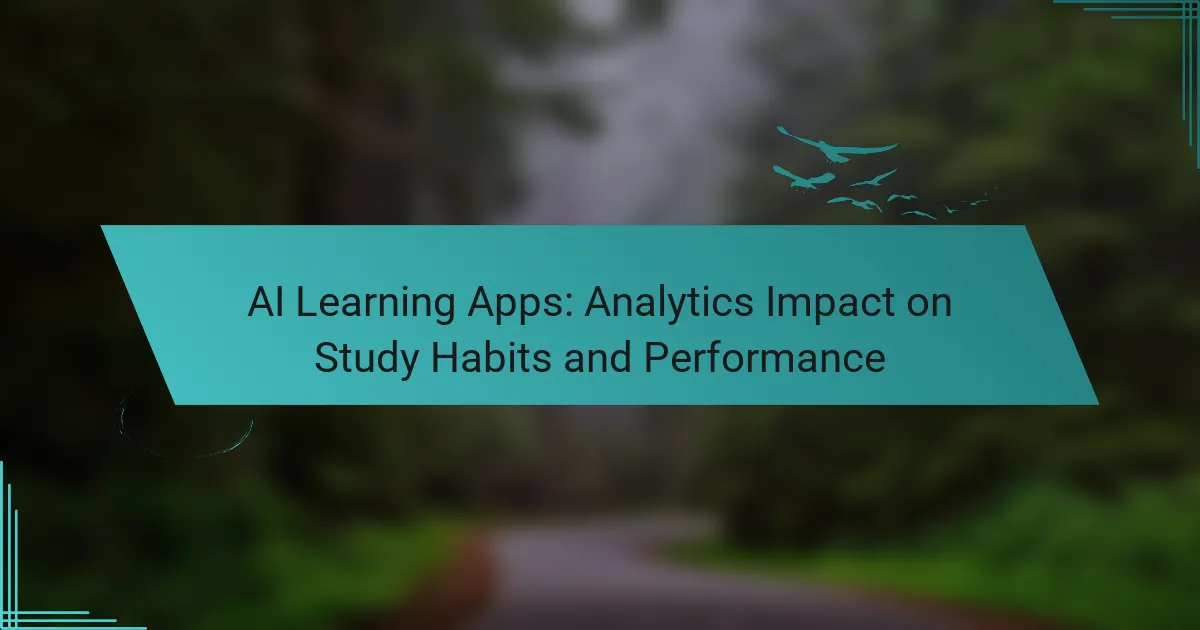AI learning apps are revolutionizing the educational landscape by offering personalized study experiences that cater to individual learning styles. By utilizing data analytics, these applications not only enhance study habits but also significantly improve academic performance by providing insights into user progress and behavior.

How Do AI Learning Apps Improve Study Habits?
AI learning apps enhance study habits by providing tailored educational experiences that adapt to individual learning styles and needs. These applications leverage data analytics to optimize study routines and improve overall academic performance.
Personalized learning experiences
Personalized learning experiences are at the core of AI learning apps, allowing users to engage with content that suits their unique preferences and pace. By analyzing user data, these apps can recommend specific resources, exercises, and study plans tailored to each learner’s strengths and weaknesses.
For example, a student struggling with mathematics might receive additional practice problems and video tutorials focused on their areas of difficulty, while another student excelling in the subject may be directed to advanced topics. This customization fosters a more effective learning environment.
Real-time feedback mechanisms
Real-time feedback mechanisms enable students to receive immediate responses to their answers, helping them understand concepts more thoroughly. This instant feedback loop encourages learners to correct mistakes on the spot, reinforcing knowledge retention and boosting confidence.
For instance, if a student answers a question incorrectly, the app can provide hints or explanations right away, guiding them toward the correct answer. This timely intervention is crucial for maintaining engagement and motivation during study sessions.
Data-driven insights for better planning
Data-driven insights allow students to analyze their study habits and performance over time, leading to improved planning and goal setting. By tracking metrics such as time spent on tasks and areas of difficulty, learners can identify patterns and adjust their study strategies accordingly.
For example, if a student notices they perform better in the morning, they might schedule their most challenging subjects during that time. This analytical approach helps learners maximize their productivity and focus on areas needing improvement.
Gamification to enhance engagement
Gamification incorporates game-like elements into learning, making study sessions more enjoyable and engaging. By introducing rewards, challenges, and progress tracking, AI learning apps motivate students to stay committed to their studies.
Features such as earning points for completing tasks or unlocking levels for mastering concepts can significantly increase user engagement. This playful approach not only makes learning fun but also encourages consistent practice and exploration of new topics.

What Analytics Features Are Most Effective?
Effective analytics features in AI learning apps include tools that provide insights into user progress, behavior, and performance. These features help learners identify strengths and weaknesses, ultimately enhancing study habits and academic outcomes.
Progress tracking dashboards
Progress tracking dashboards visually represent a learner’s journey, showcasing completed tasks, time spent on activities, and overall progress toward goals. These dashboards often use graphs and charts to make the data easily digestible, allowing users to quickly assess their achievements.
To maximize the benefits of progress tracking, users should regularly check their dashboards and set specific milestones. This practice encourages accountability and helps maintain motivation. Avoid overwhelming yourself with too much data; focus on key metrics that matter most to your learning objectives.
Behavioral analytics for habit formation
Behavioral analytics analyze user interactions with the app to identify patterns and habits that influence learning. By understanding these behaviors, learners can adjust their study routines to foster better habits, such as consistent study times or preferred learning methods.
For effective habit formation, users should look for insights on their peak productivity times and preferred study durations. Implementing small changes based on these insights can lead to significant improvements in learning efficiency. Be cautious of relying solely on analytics; personal reflection on habits is equally important.
Performance comparison tools
Performance comparison tools allow learners to benchmark their results against peers or established standards. These tools can highlight areas where users excel or need improvement, fostering a competitive yet supportive learning environment.
When using performance comparison tools, consider both individual and group metrics. Aim for personal growth rather than just outperforming others. Regularly review your performance data to identify trends and adjust your study strategies accordingly. Avoid fixating on rankings; focus instead on your own progress and learning journey.

Which AI Learning Apps Are Leading the Market?
Several AI learning apps are currently leading the market, each offering unique features that enhance study habits and performance. Notable examples include Khan Academy, Duolingo, and Coursera, which leverage analytics to personalize learning experiences and track progress effectively.
Khan Academy
Khan Academy utilizes AI to provide personalized learning paths based on student performance. The platform offers a wide range of subjects, allowing users to focus on areas where they need improvement. Analytics track progress, helping learners identify strengths and weaknesses.
Students can access thousands of instructional videos and practice exercises, making it easy to reinforce concepts. The app’s dashboard provides insights into time spent on tasks and mastery levels, enabling users to set achievable goals.
Duolingo
Duolingo is a popular language-learning app that employs AI to adapt lessons to individual users’ proficiency levels. The app analyzes user responses to tailor exercises, ensuring that learners are challenged appropriately without becoming overwhelmed.
With features like gamification and daily streaks, Duolingo encourages consistent practice. Users can track their progress through analytics that show vocabulary retention and skill levels, making it easier to stay motivated and focused on language acquisition.
Coursera
Coursera partners with universities and organizations to offer a vast array of courses, utilizing AI to enhance the learning experience. The platform’s analytics tools help learners monitor their progress and engagement, providing insights into areas that may require additional focus.
Courses often include quizzes and peer-reviewed assignments, allowing users to apply what they’ve learned. The app’s analytics can suggest courses based on past performance, helping learners navigate their educational journey effectively.

How Do Analytics Impact Student Performance?
Analytics significantly enhance student performance by providing insights into learning behaviors and outcomes. By tracking progress and identifying trends, students can adjust their study habits to improve their academic results.
Identifying knowledge gaps
Analytics tools help students pinpoint specific areas where they struggle, allowing for targeted study efforts. For example, if a student consistently performs poorly in math quizzes, analytics can highlight this trend, prompting focused review sessions on those topics.
By utilizing diagnostic assessments, students can receive feedback on their understanding of various subjects. This targeted approach can lead to more efficient study sessions and better overall performance.
Enhancing retention rates
Using analytics, students can track their retention of information over time, which is crucial for long-term learning. Tools that analyze quiz results and study patterns can suggest optimal review intervals, enhancing memory retention.
For instance, spaced repetition algorithms can recommend when to revisit material, helping students retain knowledge more effectively. This method can lead to improved test scores and a deeper understanding of the subject matter.
Boosting motivation through analytics
Analytics can significantly boost student motivation by providing tangible evidence of progress. When students see their performance metrics improve, they are more likely to stay engaged and committed to their studies.
Additionally, gamified analytics features, such as badges or progress bars, can create a sense of achievement. This positive reinforcement encourages students to set and achieve academic goals, fostering a more productive learning environment.

What Are the Key Metrics to Monitor?
Key metrics to monitor in AI learning apps include time spent on tasks, assessment scores, and engagement levels. These metrics provide insights into study habits and performance, helping users identify areas for improvement and optimize their learning strategies.
Time spent on tasks
Monitoring the time spent on tasks helps gauge how effectively a learner manages their study sessions. Ideally, learners should aim for focused study periods of around 25 to 50 minutes, followed by short breaks to enhance retention and prevent burnout.
Tracking this metric can reveal patterns, such as whether longer study sessions correlate with improved performance or if shorter, more frequent sessions yield better results. Adjusting study duration based on these insights can lead to more efficient learning.
Assessment scores
Assessment scores are critical indicators of a learner’s understanding and mastery of the material. Regularly reviewing these scores can help identify strengths and weaknesses in specific subjects or topics.
Setting benchmarks for improvement, such as aiming for a score increase of 10-20% over a set period, can motivate learners to focus on areas needing attention. Additionally, comparing scores over time can highlight progress and inform future study strategies.
Engagement levels
Engagement levels reflect how actively a learner interacts with the app and its content. High engagement often correlates with better retention and understanding, making it essential to monitor this metric closely.
To boost engagement, learners should explore features like quizzes, interactive lessons, and discussion forums. Tracking engagement can also help identify when motivation dips, allowing for timely adjustments to study habits or content focus.

How Can Educators Leverage AI Analytics?
Educators can utilize AI analytics to enhance teaching strategies and improve student outcomes. By analyzing data on student performance and engagement, educators can tailor their approaches to meet individual learning needs and optimize study habits.
Understanding Student Learning Patterns
AI analytics can identify trends in how students learn, including their strengths and weaknesses. By examining data such as time spent on tasks, quiz scores, and participation levels, educators can gain insights into effective study habits and areas needing improvement.
For example, if analytics show that a student excels in visual learning but struggles with written assignments, educators can adjust their teaching methods accordingly. This targeted approach can lead to better academic performance and increased student motivation.
Personalizing Learning Experiences
AI analytics enables the customization of learning experiences based on individual student data. By leveraging insights from analytics, educators can create personalized learning plans that cater to each student’s unique needs and preferences.
For instance, if analytics indicate that a group of students is consistently performing below average in math, educators can implement additional resources or tutoring specifically for that subject. This tailored support can significantly enhance overall learning outcomes.
Monitoring Progress and Adjusting Strategies
Regularly reviewing AI-generated analytics allows educators to monitor student progress effectively. By tracking performance over time, educators can identify patterns and make timely adjustments to their teaching strategies.
For example, if a particular teaching method yields declining results, educators can pivot to alternative approaches based on real-time data. This adaptability is crucial in maintaining student engagement and ensuring academic success.
Encouraging Student Engagement
AI analytics can help educators foster greater student engagement by providing insights into what motivates learners. Understanding which activities or resources resonate most with students allows for the development of more engaging curricula.
For instance, if analytics reveal that interactive quizzes lead to higher participation rates, educators can incorporate more of these tools into their lessons. This not only enhances learning but also encourages students to take an active role in their education.
